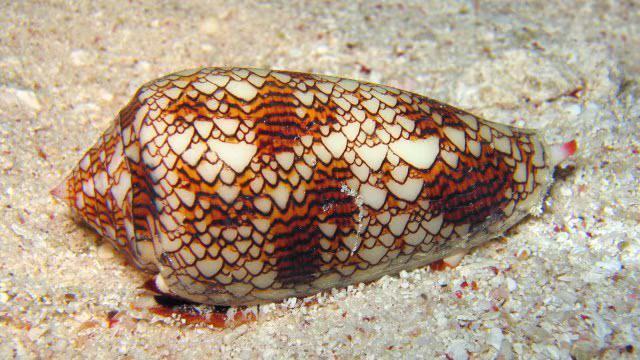
Textile Cone Snail’s Venom Can Stop a Human Heart: Scientists
When we think of snails, we often picture slimy creatures that leave trails of goo behind them as they slowly make their way across the ground. But did you know that there is a type of snail that can pack a deadly punch? The textile cone snail, found in warm ocean waters, especially around coral reefs in tropical and subtropical zones, has venom that can cause numbness, muscle paralysis, and even respiratory failure. In extreme cases, it can even stop a human heart from beating.
For years, scientists from the University of Utah and the Smithsonian have been studying the venom of this deadly snail, known scientifically as Conus textile. Their research has shed light on the complex makeup of the venom and its potential to cause harm to humans.
The textile cone snail is a type of marine snail that is found in the warm waters of the Atlantic, Pacific, and Indian Oceans. It is known for its beautiful, intricate shell, which is often adorned with vibrant colors and patterns. But don’t let its beauty fool you – this snail is a predator that uses its venom to catch its prey.
When a textile cone snail senses the presence of a potential meal, it will release its venom into the water. The venom is made up of a complex mixture of compounds, including neurotoxins, that can cause a range of symptoms in animals that come into contact with it.
For humans, the effects of textile cone snail venom can be severe. The venom can cause numbness, muscle paralysis, and respiratory failure, which can be fatal if left untreated. In extreme cases, the venom can even cause a human heart to stop beating.
So, how does this happen? When a person is stung by a textile cone snail, the venom is released into their bloodstream. The venom then travels to the brain, where it can cause a range of symptoms, including numbness, muscle paralysis, and respiratory failure. In extreme cases, the venom can even cause a human heart to stop beating.
The reason why the venom is so potent is due to the unique makeup of the venom itself. The venom is made up of a complex mixture of compounds, including neurotoxins, that are designed to target specific parts of the nervous system. These compounds can cause a range of symptoms, including numbness, muscle paralysis, and respiratory failure.
In addition to its use as a predator, the venom of the textile cone snail has also been used by humans for a number of purposes. One of the most well-known uses of the venom is in the production of painkillers. The venom contains a compound called conotoxin, which is used to create a range of painkillers, including some of the strongest opioids available.
The study of the venom of the textile cone snail is also shedding light on the potential for new treatments for a range of diseases. For example, researchers have discovered that the venom contains compounds that can help to relieve pain and reduce inflammation. These compounds could potentially be used to create new treatments for conditions such as arthritis and fibromyalgia.
In addition to its potential medical uses, the study of the venom of the textile cone snail is also providing new insights into the biology of the snail itself. For example, researchers have discovered that the snail’s venom is used not only to catch its prey, but also to defend itself against predators.
The venom of the textile cone snail is a complex and fascinating substance that is still not fully understood. Further research is needed to uncover the full range of its potential uses and to understand the ways in which it works.
In conclusion, the textile cone snail’s venom is a powerful and fascinating substance that is capable of causing numbness, muscle paralysis, and respiratory failure in humans. While it is a deadly predator, its venom also holds great potential for use in medicine and other fields. Further research is needed to fully understand the properties and uses of this venom, but it is clear that it is a substance that is worthy of further study.






